What if everything you thought you knew about the last days of the Beatles was wrong? That seems to be the question behind Peter Jackson’s reframing of Michael Lindsay-Hogg’s famously – or rather, infamously – miserable documentary Let It Be.
The year was 1969 and the Beatles hadn’t performed live since their world tour in ’66. The band commissioned a director, Michael Lindsay-Hogg, to shoot their journey in putting together a new album and their eventual return to the stage. This footage was part of a three pronged comeback strategy that included the album release, a TV special, and their first public performance in years. But by the time Lindsay-Hogg’s work finally came out in 1970 – after numerous delays and alleged meddling by the band members – the end result was more of a cinéma vérité installation than an actual documentary.
Making things worse was the fact that the Beatles had just broken up. This layer of finality meant that Let It Be was long perceived as a work that was gloomy and grim, and forever cursed to be looked upon only with hindsight, with all of the baggage that comes with the breaking up of the Beatles.
And that was that. Or at least it was for the last 51 years.
Enter lifelong Beatles fan Peter Jackson who, along with his crack team of movie magicians, has spent the last few years squirreled away in some editing suite, painstakingly plowing through nearly 60 hours of film and 150 hours of audio, watching, editing, and restoring everything that Michael Lindsay-Hogg shot in order to give us the truest possible reflection of who the Beatles were in their final days as a band.
The result of which is The Beatles: Get Back, an epic, eight hour spectacle that drops over three nights on Disney Plus Hotstar, and a completely new take on something we all thought we had closed the book on.
Almost Famous
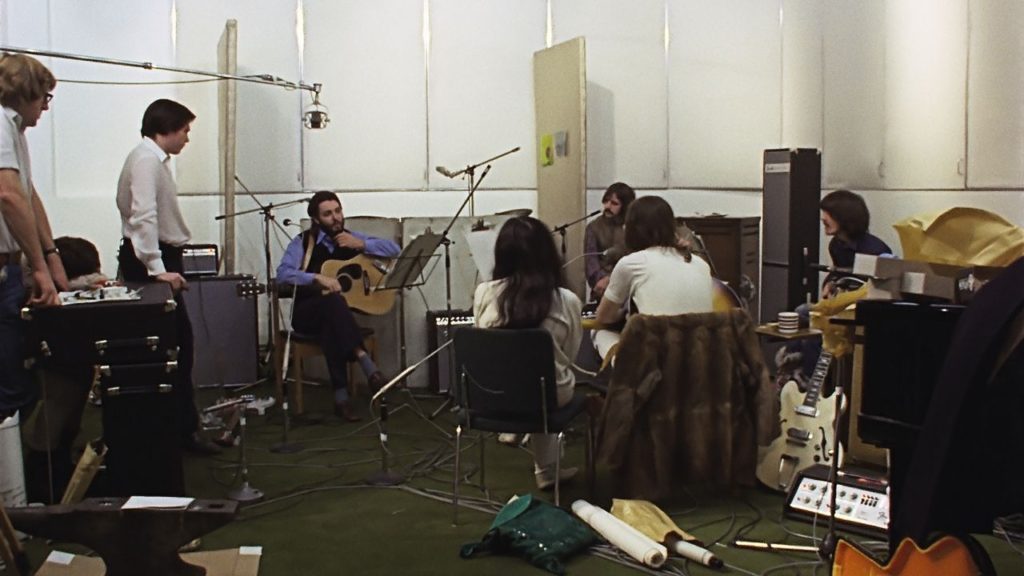
Umapagan Ampikaipakan: I wasn’t sure if this was going to be a review or just an unrestrained stream of emotion. Watching The Beatles: Get Back had me in tears. I had to keep reminding myself that these weren’t actors playing the Beatles, that it wasn’t a reenactment, that it was all real.
Now don’t get me wrong. I understand the science and skill that goes into such a restoration. I have a pretty good idea of how it all works. And yet, watching it, I couldn’t help but think of it as being something magical. I couldn’t believe that this is something that exists.
There’s a finite amount of imagery that we have of the Beatles at their prime. As fans, we’ve seen all of it. The newsreel footage. The interviews. Their appearance on Ed Sullivan. All of it. But we’ve never seen them like this. Not like this. Not in high-definition and in living colour. We’ve never heard them like this. Candid. Unrehearsed. Their voices crystal clear. Not drowned out by guitars or screaming fans. This is lore made new. This is sublime.
Bahir Yeusuff: I knew there would be tears coming into this, but I really wasn’t expecting how I would be so completely moved even the most mundane things. You’re right, this is probably the most intimate we’ve ever been able to see this band of rock gods. The way George Martin would have seen them. The way the engineers and roadies would have seen them.
All of this was (obviously) before the age of social media and the honesty, and just the absolute reality of it all, is laid bare for us to see. And it is so fascinating. I get it, social media is just as curated and designed as a live performance, but it feels like there is even less of a facade here. The Beatles aren’t hanging out with strangers. They aren’t trying to look cool and composed. This is just them rehearsing and writing songs without the need to put up walls in order to protect themselves from the public.
The big thing that Peter Jackson did here was to provide a narrative structure to the footage, which is something Michael Lindsay-Hogg never did in Let It Be. Here there is a bigger narrative arc: the band have got this thing they want to do, they have a limited time to do it in, and they don’t have all the pieces in place yet. There is a timeline, and there is tension, and there is drama. All the perfect ingredients of a great piece of fiction. Only it isn’t.
Context Is Everything
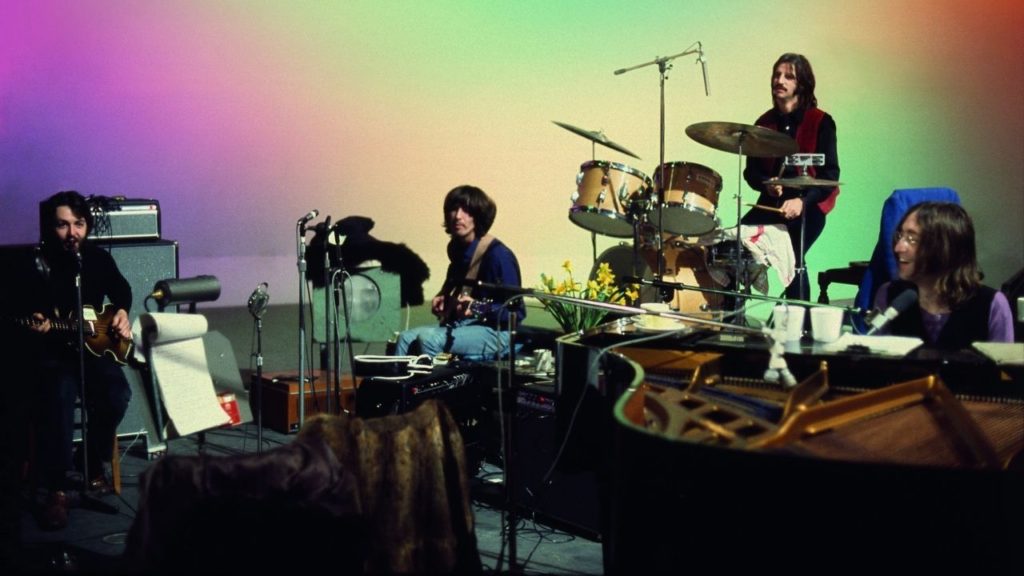
UA: After a 10 minute prologue, a brief history of the Beatles if you will, Get Back begins the exact same way as Let It Be, with shots of their road manager, Mal Evans, setting up the soundstage before the band arrives. The difference being that there is context here. Jackson uses title cards to introduce us to the various players as well as set the scene. It’s still very fly-on-the-wall, but there is not this narrative device that guides us through the piece.
Michael Lindsay-Hogg’s Let It Be was an avant-garde piece of observational filmmaking. Peter Jackson’s Get Back has a plot. (The first part even ends on a cliffhanger!) He approaches this as a storyteller. Before this, I didn’t know that the guy in the maroon jacket was their road manager, Mal Evans. Heck, I didn’t even know that the jacket he was wearing was maroon!
BY: And that context makes all the difference. You realize that this band is so much more than just the Fab Four. Mal Evans was helping write the words to songs as Paul and John were pulling them together. He was no longer just the random guy hitting the anvil with a hammer in Maxwell’s Silver Hammer. That context that Peter Jackson put back into the footage helps the audience really get into it. God knows, it certainly helped me.
I also was not expecting to see (and hear!) so much of Lindsay-Hogg in the footage.
UA: Which highlights just what Peter Jackson was trying to do with this restoration. Yes, it is an unvarnished look at the creation myth behind the Beatles’ last album. Yes, it is a character study of the dynamics behind these musical geniuses. But by including Michael Lindsay-Hogg, by making him a part of this movie, it is also an insiders take on the making of his documentary. Which feels like an attempt by Jackson to vindicate Let It Be by showing us just how impossible it must have been at the time to make something that appeased everyone and every interest.
Searching For Good Times
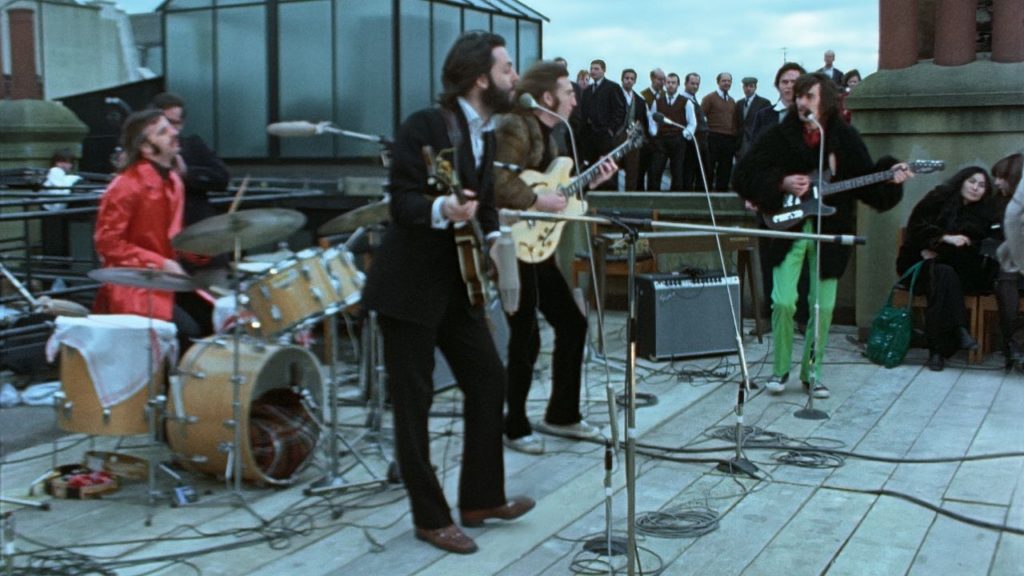
UA: The Beatles: Get Back shows us just how important time is. Because we need time to tell a good story. But we also need time to be able to look back and reflect on our past and our memories.
The documentary confirms what we long suspected. That the allegedly tense moments between the band – one exchange between McCartney and Harrison is often highlighted as being predictive of their imminent demise – were in fact the kind of familiar bickering that is commonplace in a family. That tense moment between Paul and George, when given time to breathe, when played out in its entirety, feels like the kind of open and honest creative conflicts that occur when artists collaborate. There is an end to that conversation that we don’t get to hear in Let It Be. And it will completely change your perspective.
BY: Get Back also had a lot of moments of genuine joy in that rehearsal space. And quite a few of them included Yoko Ono! After watching that first episode, I no longer saw her as the villain she’s been made out to be.
Watching this, I couldn’t help but compare it to Let It Be. I found myself constantly thinking about the editing decisions that Lindsay-Hogg must have had to make in order to get it all down to his 80 minute runtime. I also couldn’t stop myself from thinking about what I know happens later as Lindsay-Hogg and the band discuss what form the film would take, or what they would do as their big performance to cap the film.
There are also many moments that would only be of interest to us all these years later. Like how the Apple Records publisher comes by to show the band the publishing rights that they’ve gotten. Or when John Lennon is discussing the concert set design with a designer. They seem mundane, but it really goes to show that there really was a lot involved in being a Beatle, and that it was all on them.
It’s those small moments, that would normally have ended up on the cutting room floor, that I found the most fascinating. Lindsay-Hogg pitching to the band about performing in Libya. Or how the recording equipment was loaned to the band from George Harrison’s home studio. Or the fact that Eric Clapton’s guitar abilities were being discussed. There are just so many little tidbits of interesting things that had me constantly reaching for the rewind button.
Get Back Jojo
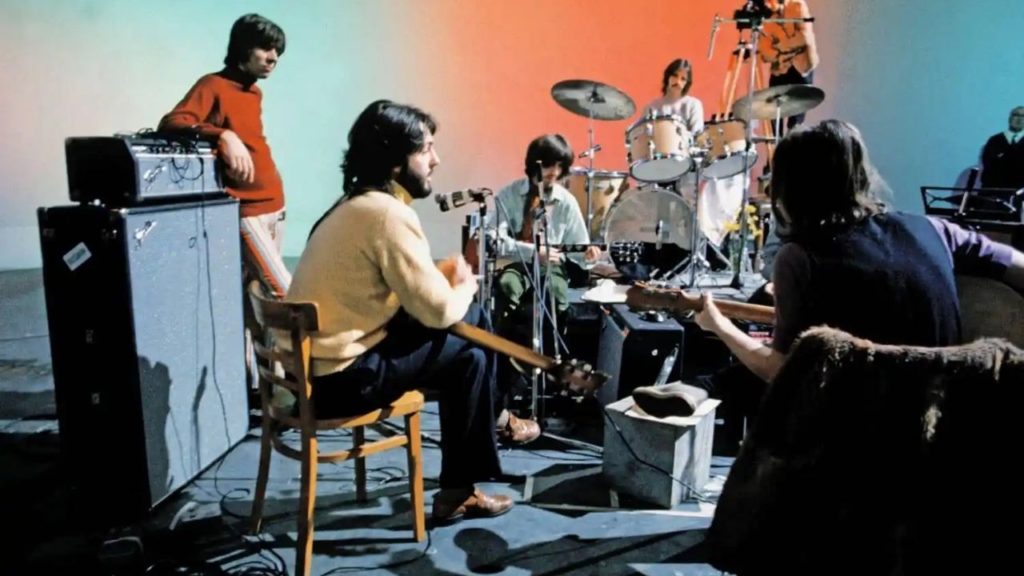
BY: And then there were these moments of pure, honest-to-God magic. Like when Paul McCartney pulls the song “Get Back” from the ether. I had goosebumps. I had to pause, and go back, and rewatch that several times. To see a song so iconic just happen in front of your very eyes was astounding.
UA: That moment with Get Back, when they’re under pressure to come up with enough music for an album, is not something you can ever hope to recreate. It is genius captured on tape. For history. For posterity. It cannot be explained. It cannot be described. It just happens. You needed to be there. And we were. For that alone, I am forever grateful to Peter Jackson.
But I want to go back to what you were saying about just how involved the band was in every aspect of their brand. After Brian Epstein’s untimely passing, the four boys took on managerial duties themselves. And they were boys. Here they were – aged between 25 and 28, having already lived full lives, with wives and ex-wives, through death and scandal, and very well aware of their influence – not just creating revolutionary music, but also moving the needle on the business of music.
With Get Back, we get more than just a glimpse of that. We get to see them at work. We see why the Beatles were lightning in a bottle. Why this combination of these four individuals worked in a way unlike any band before or any band since.
BY: There is so much here to savour if you are a fan of the Beatles. But I will admit that it is long. Besides being a marathon of emotions, an eight hour documentary is just extraordinarily long. I won’t go so far as to say that watching it was boring, or a slog, but it really does require some stamina on your part.
I understand how, as a super-fan, Peter Jackson may have found everything precious, but at the same time, I wonder if there isn’t just a little bit of fat in here that could be trimmed out to get it to a more palatable runtime. I only say that because I want people to get into this, because I know it’ll be hard to convince someone to sit down for two and a half hours at a time to watch a band pull together an album and a performance.
You’re going to disagree with me because you want all 60 hours of footage right?
UA: Oh no. I agree with you. The reason this works so well is because it has authorial intent. 60 hours of raw footage doesn’t mean anything unless it’s been constructed to tell a story. Which was the problem with Michael Lindsay-Hogg’s version. Given all the restrictions placed on him at the time, Let It Be was less of a movie and more of something that captured a mood.
That said, it feels a little unfair comparing the two movies because Michael Lindsay-Hogg just didn’t have the creative freedom, time, and hindsight that Jackson had.
The Beatles: Get Back is a movie that could only exist now.
BY: Enough time has passed that we’re no longer coloured by the infighting and the negativity that followed the end of the band. As fans, we are at that point where we can look back, acknowledge, and enjoy the genius of these four guys, without being swayed by all the ugliness that came after. At least that’s where I find myself. These three episodes will allow me a look into a very specific moment and enjoy it for what it was and for what it is.
UA: I also want to make a case for why this is an important watch. Even if you aren’t a fan of the Beatles, I believe that this is time well spent. That it is a commitment worth making.
We’re always trying to get to the heart of what makes a genius. For decades, there have been movies and documentaries, books and journalism, that have been dedicated to trying to explain what it is, how it works, and whether or not it can be replicated.
Watching this might be the closest thing we have to experiencing genius at work. It doesn’t have any of the artifice that Ron Howard needed to create in a movie like A Beautiful Mind. It doesn’t need to use metaphor as a way to explain it to the rest of us common folk.
Here, we are allowed to bear witness to how their brains work. They aren’t just messing about in a room when they come up with “Get Back.” They’re painting, building, inventing the sonic landscape of our lives as they allow their mouths, hands, and legs to channel everything they think and feel into sound and music.
I said it before and I’ll say it again. You just need to be there. And for the first time, we’re given that opportunity. To be there. To stay as long as we like. To take in all of this wonder. To be moved and inspired.
I’m always lamenting the fact that I was born too late and therefore missed out on so much greatness. I never got the chance to see Queen at Wembley. Or the Rolling Stones at their prime. Or experience the Beatles for the first time at their first time. Watching this made me feel different.
So, forget The Lord of the Rings, and The Frighteners, and King Kong, and those infernal Hobbit movies. Peter Jackson’s legacy lies with both They Shall Not Grow Old and The Beatles: Get Back. The function of cinema is to entertain, enlighten, and influence. It serves to direct us as a society. And what he has accomplished with both of these documentaries is nothing short of miraculous. They eliminate the gulf between then and now, between past and present, showing us the world in a fresh light and teaching us something new about ourselves.




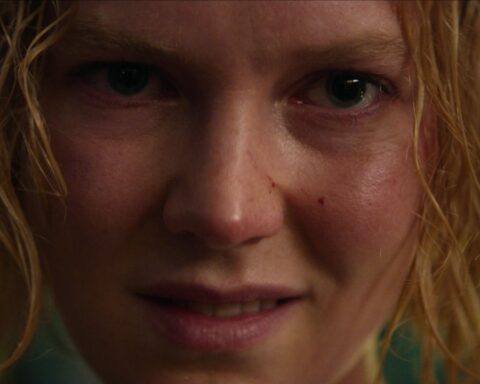

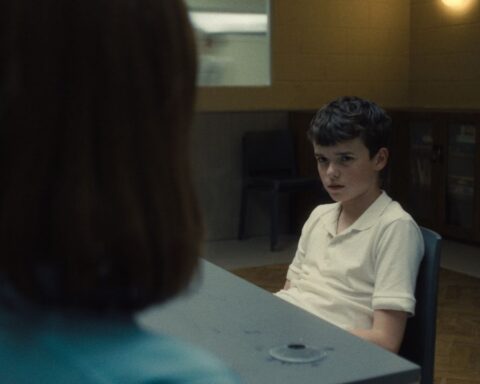
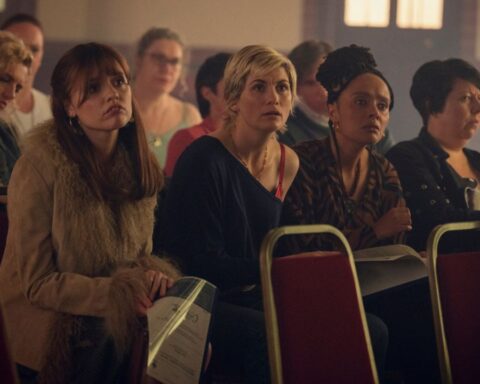

Follow Us